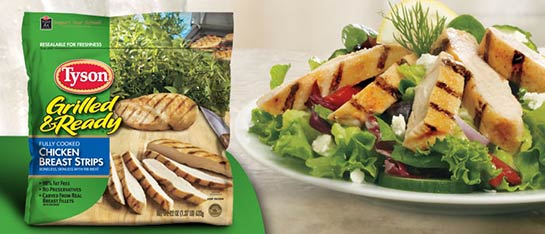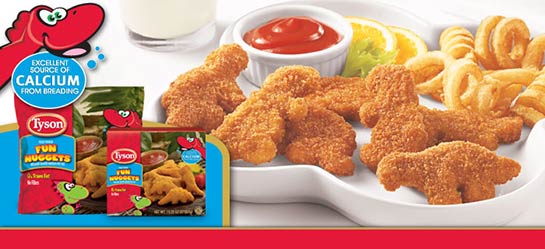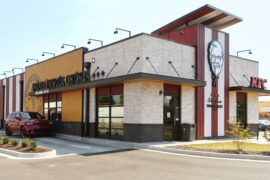Tyson Foods Inc, the world’s second largest processor of chicken, beef and pork, on Monday reported a 4% rise in sales for the fourth quarter ending on October 3, as receipts totaled $10.51 billion compared to $10.1 billion the year before. Net income advanced by $258 million.
For the 2015 fiscal year, adjusted operating income rose 37% to $2.25 billion on total sales of $40.6 billion, which was up by 9% over the prior year.
“Fiscal 2015 was an important year for Tyson Foods, because it proved that our house of brands gives us the ability to produce record sales and earnings in less than optimum conditions, all while successfully merging two large companies,” said Donnie Smith, president and chief executive officer of Springdale, Arkansas, USA-headquartered Tyson Foods.

The company generated adjusted sales of more than $40 billion and adjusted EPS of $3.15, generated free cash flow of more than $1.5 billion, reduced net debt by $1.7 billion, repurchased $250 million of our stock in the fourth quarter and launched Ball Park Jerky and Hillshire Snacking – two entirely new platforms.
“Our business model is working,” said Tyson. “The Prepared Foods segment [which includes numerous value-added frozen products such as Grilled & Ready Chicken Breast Strips and kid-friendly Fun Nuggets] had a very strong performance in the first full year of Tyson and Hillshire coming together. The Chicken segment had an outstanding year. Pork produced solid results. Beef experienced a tough operating environment during most of fiscal 2015, but the other segments more than made up for it.”
He continued: “We’re expecting another record year in fiscal 2016. Our projections indicate adjusted EPS of $3.50 to $3.65, consistent with our goal of averaging at least 10% annual EPS growth over time. We plan to continue repurchasing our shares; in fact, we’ve already bought back $200 million of our stock so far in the first quarter of fiscal 2016.

Summary of Segment Results
- Chicken: Adjusted sales volume grew as a result of stronger demand for chicken products and mix of rendered product sales. Adjusted average sales price decreased as feed ingredient costs declined, partially offset by mix changes. Adjusted operating income increased due to higher sales volume and lower feed ingredient costs, partially offset by disruptions caused by export bans. Adjusted feed costs decreased $130 million and $440 million during the fourth quarter and 12 months of fiscal 2015, respectively.
- Beef: Adjusted sales volume decreased due to a reduction in live cattle processed. Adjusted average sales price decreased in the fourth quarter of fiscal 2015 due to higher domestic availability of fed cattle supplies, which drove down livestock costs. For the 12 months of fiscal 2015, adjusted average sales price increased due to lower domestic availability of beef products. Adjusted operating income decreased due to unfavorable market conditions associated with a decrease in supply which drove up fed cattle costs, export market disruptions, the relative value of competing proteins and increased operating costs. Additionally, the company incurred $70 million of losses in the fourth quarter of fiscal 2015 from mark-to-market open derivative positions and lower-of-cost-or-market inventory adjustments as a result of a large and rapid decline in live cattle futures during September.
- Pork: Adjusted sales volume decreased due to the divestiture of the company’s Heinold Hog Markets business in the first quarter of fiscal 2015. Excluding the impact of the divestiture, adjusted sales volume grew 6.5% and 3.5% for the fourth quarter and 12 months of fiscal 2015, respectively, driven by better demand for pork products. Live hog supplies increased, which drove down livestock cost and adjusted average sales price. While reduced compared to the prior year, adjusted operating income remained strong as the company maximized revenues relative to live hog markets, partially attributable to operational and mix performance.
- Prepared Foods: Adjusted sales volume increased due to incremental volumes from the acquisition of Hillshire Brands. Adjusted average sales price increased primarily due to better product mix, which was positively impacted by the acquisition of Hillshire Brands. Adjusted operating income improved due to an increase in sales volume and average sales price mainly attributed to Hillshire Brands, as well as lower adjusted raw material costs of approximately $85 million and $285 million for the fourth quarter and 12 months of fiscal 2015, respectively, related to Tyson’s legacy Prepared Foods business. Additionally, profit improvement initiatives and Hillshire Brands synergies positively impacted Prepared Foods operating income by $81 million and $285 million for the fourth quarter and 12 months of fiscal 2015, respectively.
Looking Ahead
In fiscal 2016, the company expects US protein production (chicken, beef, pork and turkey) to increase approximately 3% from fiscal 2015 levels. Additionally, it anticipates disruptions related to export bans to continue in fiscal 2016. As the integration of Hillshire Brands proceeds, it expects to realize synergies of more than $500 million in fiscal 2016 and more than $700 million in fiscal 2017. The majority of these benefits will be realized in our Prepared Foods segment.
The following is a summary of the outlook for each segment, as well as an outlook on sales for fiscal 2016.
- Chicken: USDA data shows an increase in production of around 2% in fiscal 2016 compared to fiscal 2015. However, more recent data indicates a greater increase in supply that could outpace the demand. Based on current futures prices, the company expects lower feed costs in fiscal 2016 compared to fiscal 2015 of approximately $100 million. Many of Tyson’s sales contracts are formula-based or shorter-term in nature, but there may be a lag time for price changes to take effect. For fiscal 2016, the Chicken segment’s operating margin should exceed 10%.
- Beef: The company expects industry fed cattle supplies to be flat to slightly higher in fiscal 2016 compared to fiscal 2015. Although adequate supplies are generally anticipated in regions where Tyson operates plants, there may be periods of imbalance of fed cattle supply and demand. We are adjusting our normalized range of the Beef segment is being adjusted to 1.5-3.0% based on historical performance and future expectations given existing beef fundamentals, tight cattle supplies and an imbalance of processing capacity. For fiscal 2016, it is anticipated that the Beef segment’s operating margin should approximate the low end of the new range.
- Pork: Industry hog supplies are expected to increase around 2-3% in fiscal 2016 compared to fiscal 2015. The Pork segment’s operating margin will be in its normalized range of 6-8%.
- Prepared Foods: Lower raw material costs of approximately $350 million is expected in fiscal 2016. As Tyson continues to invest heavily in innovation, new product launches and the strengthening of brands, its operating margin should be near the low-end of our expected range of 10-12% in fiscal 2016.
- Other: In the fourth quarter of fiscal 2015, Tyson began reporting the International segment in Other following the sale of its Mexican and Brazilian poultry operations. As a result, Other includes our foreign business related to raising and processing live chickens in China and India. It’s expected that Other adjusted operating loss should be approximately $50 million in fiscal 2016.
- Sales: Tyson expects revenues to approximate $41 billion for fiscal 2016 as it grows current businesses to offset the impact of fiscal 2015 divestitures.





